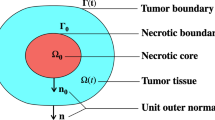Abstract
We consider a time-dependent free boundary problem with radially symmetric initial data: σ
t
− Δσ + σ = 0 if  and σ(r,0)=σ0(r) in {r < R(0)} where R(0) is given. This is a model for tumor growth, with nutrient concentration (or tumor cells density) σ(r,t) and proliferation rate
and σ(r,0)=σ0(r) in {r < R(0)} where R(0) is given. This is a model for tumor growth, with nutrient concentration (or tumor cells density) σ(r,t) and proliferation rate  then there exists a unique stationary solution (σ
S
(r), R
S
), where R
S
depends only on the number
then there exists a unique stationary solution (σ
S
(r), R
S
), where R
S
depends only on the number  . We prove that there exists a number μ
*, such that if μ < μ
* . . . then the stationary solution is stable with respect to non-radially symmetric perturbations, whereas if μ > μ
* then the stationary solution is unstable.
. We prove that there exists a number μ
*, such that if μ < μ
* . . . then the stationary solution is stable with respect to non-radially symmetric perturbations, whereas if μ > μ
* then the stationary solution is unstable.
Similar content being viewed by others
References
Abramowitz, M., Stedgun, I.A.: Handbook of mathematical functions with formulas, graphs, and mathematical tables. Wiley-Interscience Publication, New York, 1972
Adam, J.A.: General aspect of modeling tumor growth and immune response. A Survey of Models for Tumor-Immune System Dynamics. Adam, J.A., Bellomo, N. (ed.), Birkhäuser, Boston, pp. 14–87, 1996
Adam, J.A., Maggelakis, S.A.: Diffusion regulated growth characteristics of a spherical prevascular carcinoma. Bull. Math. Biol. 52, 549–582 (1990)
Bazaliy, B.V., Friedman, A.: A free boundary problem for elliptic-parabolic system: application to a model of tumor growth. Comm. Partial Differential Equations. 28, 517-560, (2003)
Bazaliy, B.V., Friedman, A.: Global existence and asymptotic stability for an elliptic-parabolic free boundary problem: an application to a model of tumor growth. Indiana Univ. Math. J. 52, 1265–1304, (2003)
Britton, N., Chaplain, M.A.J.: A qualitative analysis of some models of tissue growth. Math. Biosci. 113, 77–89 (1993)
Byrne, H.M.: The importance of intercellular adhesion in the development of carcinomas. IMA J. Math. Appl. Med. Biol. 14, 305–323 (1997)
Byrne, H.M.: A weakly nonlinear analysis of a model of avascular solid tumor growth. J. Math. Biol. 39, 59–89, (1999)
Byrne, H.M., Chaplain, M.A.J.: Growth of nonnecrotic tumors in the presence and absence of inhibitors. Math. Biosci. 130, 151–181, (1995)
Byrne, H.M., Chaplain, M.A.J.: Modelling the role of cell-cell adhesion in the growth and development of carcinomas. Math. Comput. Modelling. 24, 35–55, (1996)
Byrne, H.M., Chaplain, M.A.J.: Growth of nonnecrotic tumors in the presence and absence of inhibitors. Math. Biosci. 135, 187–216, (1996)
Chaplain, M.A.J.: The development of a spatial pattern in a model for cancer growth. Experimental and Theoretical Advances in Biological Pattern Formation. Othmer, H.G., Maini, P.K., Murray, J.D. (ed.), Plenum Press, 45–60, 1993
Chen, A., Friedman, A.: A free boundary problem for elliptic-hyperbolic system: an application to tumor growth. SIAM J. Math. Anal. 35, 974–986 (2003)
Erdelyi, A., Magnus, W., Oberhettinger, F., Tricomi, F.: Higher transcendental functions. Bateman Manuscript, Volume 2, McGraw-Hill, New York, 1953
Fontelos, M., Friedman, A.: Symmetry-breaking bifurcations of free boundary problems in three dimensions. Asymptot. Anal. 35, 187–206, (2003)
Fontelos, M., Friedman, A.: Symmetry-breaking bifurcations of chagred drops. Arch. Ration. Mech. Anal. 172, 267–294, (2004)
Friedman, A., Reitich, F.: Analysis of a mathematical model for growth of tumor. J. Math. Biol. 38, 262–284, (1999)
Friedman, A., Reitich, F.: Symmetry-breaking bifurcation of analytic solutions to free boundary problems: an application to a model of tumor growth. Trans. Amer. Math. Soc. 353, 1587–1634, (2000)
Friedman, A., Reitich, F.: Nonlinear stability of a quasi-static Stefan problem with surface tension: a continuation approach. Ann. Sc. Norm. Super. Pisa Cl. Sci. 30, 341–403, (2001)
Greenspan, H.P.: Models for the growth of a solid tumor by diffusion. Stud. Appl. Math. 52, 317–340, (1972)
Greenspan, H.P.: On the growth of cell culture and solid tumors. J. Theoret. Biol. 56, 229–242, (1976)
Maggelakis, S.A., Adam, J.A.: Mathematical model for prevasculat growth of a spherical carcinoma. Math. Comp. Modelling. 13, 23–38, (1990)
McEwain, D.L.S., Morris, L.E.: Apoptosis as a volume loss mechanism in mathematical models of solid tumor growth. Math. Biosci. 39, 147–157, (1978)
Watson, G.N.: A treatise on the theory of Bessel functions, 2nd edition. Cambridge University Press, Cambridge, 1944
Weinberger, H.F.: The stability of solutions bifurcating from steady or periodic solutions. Dynamical systems (Proc. Internat. Sympos., Univ. Florida, Gainesville, Fla., 1976). Academic Press, New York, 349–366, 1977
Author information
Authors and Affiliations
Corresponding author
Additional information
Communicated by P.H.Rabinowitz
Rights and permissions
About this article
Cite this article
Friedman, A., Hu, B. Bifurcation From Stability to Instability for a Free Boundary Problem Arising in a Tumor Model. Arch. Rational Mech. Anal. 180, 293–330 (2006). https://doi.org/10.1007/s00205-005-0408-z
Received:
Accepted:
Published:
Issue Date:
DOI: https://doi.org/10.1007/s00205-005-0408-z



